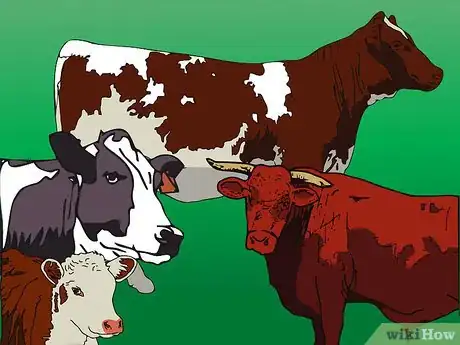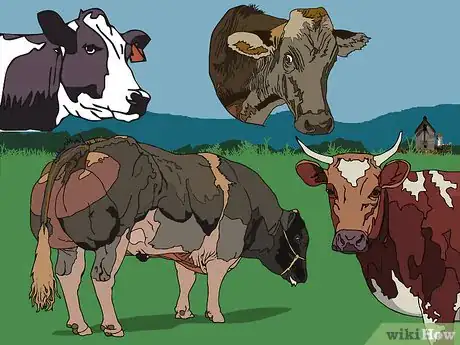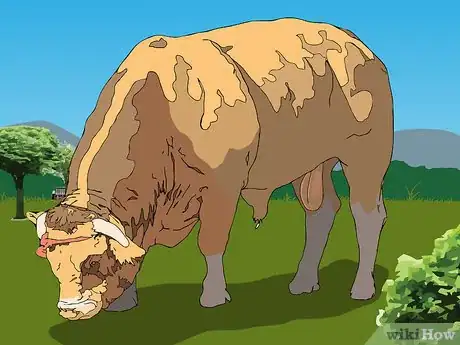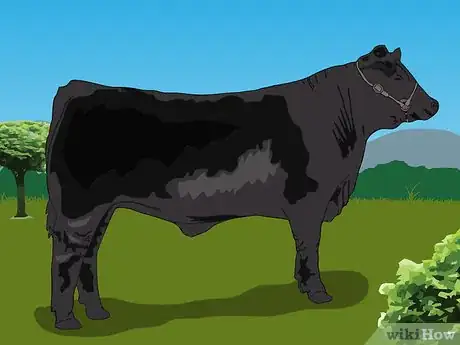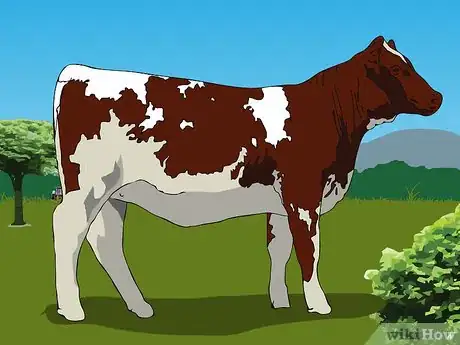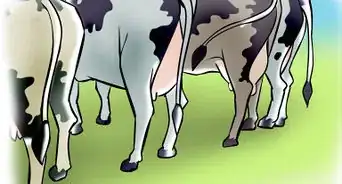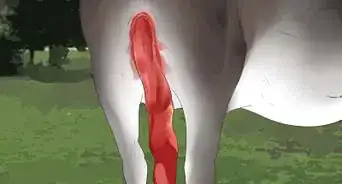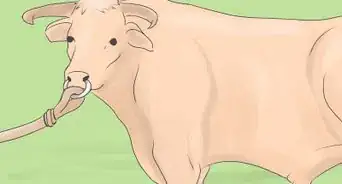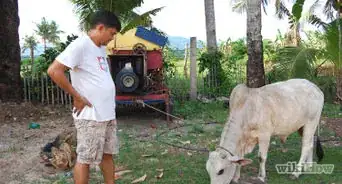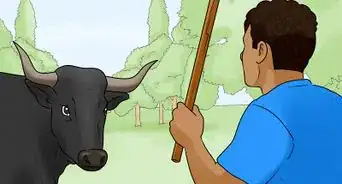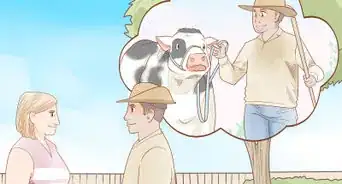This article was co-authored by Karin Lindquist. Karin Lindquist earned a BSc in Agriculture as an Animal Science major from the University of Alberta, Canada. She has over 20 years of experience working with cattle and crops. She's worked for a mixed-practice veterinarian, as a sales representative in a farm supply store, and as a research assistant doing rangeland, soil, and crop research. She currently works as a forage and beef agriculture extension specialist, advising farmers on a variety of issues relating to their cattle and the forages they grow and harvest.
wikiHow marks an article as reader-approved once it receives enough positive feedback. In this case, 88% of readers who voted found the article helpful, earning it our reader-approved status.
This article has been viewed 1,050,698 times.
There are many people worldwide who think they know what cattle look like but cannot properly tell the difference between a cow, bull, steer or heifer. Most of these people have not been taught how to distinguish between the four. This step-by-step article is intended to teach anyone how to properly distinguish between these different types of cattle.
Steps
-
1Learn the relevant definitions. These are:
- Cow: a mature female bovine that has given birth to at least one or two calves. Colloquially, the term "cow" is also in reference to the Bos primigenius species of domestic cattle, regardless of age, gender, breed or type. However for most people who work with or raise cattle, this term is not used in the same reference as previously noted.
- Bull: a mature, intact (testicles present and not removed) male bovine used for breeding purposes.
- Steer: a male bovine (or bull) that has been castrated before reaching sexual maturity and is primarily used for beef.[1]
- Stag: a male bovine (or bull) that has been castrated after or upon reaching sexual maturity and is primarily used for beef, but can and is also often used as a "gomer bull" for detecting cows and heifers in heat.
- Heifer: a female bovine (often immature, but beyond the "calf" stage) less than 1 to 2 years of age that has never calved. Such females, if they've never calved beyond two years of age may also be called heiferettes.
- Bred Heifer: a female bovine that is pregnant with her first calf.
- First-calf Heifer or First-calver: a female bovine that has given birth to her first calf, and is often around 24 to 36 months of age, depending on the breed and when she was first bred.
- Ox (plural: Oxen): a bovine that is trained for draft work (pulling carts, wagons, plows, etc.)This is a term that primarily refers to a male bovine that has been castrated after maturity. However, an ox can also be female bovine (cow or heifer) or even a bull that has been trained for the same purpose. The word 'ox' was once a general term used, just like with the term "cows," to a domesticated bovine regardless of age, gender, breed, type, or draft purposes.
- Calf (plural: Calves): an immature bovine (male and female) that is reliant on milk from its dam or from a bottle in order to survive and grow. A calf is known as such from birth to around 10 months of age.
- Bull calf: an immature intact male bovine (since all males are born with testes) that is reliant on milk from his dam or a bottle for growth and survival.
- Steer calf: an immature male bovine that has been castrated a few days to a couple months after birth, and is reliant on milk from his dam or a bottle for growth and survival.
- Heifer calf: an immature female bovine that is reliant on milk from her dam or a bottle for growth and survival.
- Freemartin: an infertile or sterile heifer or heifer calf. Such infertility is a result of being maternally twinned with a bull calf and whose placental tissues were shared in the womb. During the first trimester, reproductive organs start to form and sexual hormones begin to be produced in the fetus. When male and female fetal calves are twinned together, the testosterone produced by the male inhibits estrogen production in the female. This results in abnormal, underdeveloped or hermaphroditic reproductive organs in the female fetus. This is not so for the male. Freemartins are sometimes referred to as "hermaphrodites" if they are born with reproductive organs of both genders. As a result, this type of freemartins tend to develop secondary male sexual characteristics (muscular crest over neck, wide forehead, etc.) upon reaching puberty.
- Cattle: general plural term for more than one bovine
- Cattlebeast/bovine/animal: a singular term for a bovine whose gender cannot be determined, particularly when viewed at a distance. Most people like to refer to a bovine of unknown (or "unknown") gender as a "cow," simply because it is a much more well-known and popular term to use than "bovine" or "cattle beast." This, however, is often not the case around experienced cattlemen and cattle women or "ranchers" (as some like to call them) who never use the term "cow" when referring to a bovine that is anything but a cow. "Animal," "critter," "creature," or any other term, coarse or not, are most often used over the colloquial word "cow." !
-
2Understand the myths surrounding the ability of being able to distinguish the sex or gender of a bovine.
- Only bulls are horned; cows are polled: This is a myth. The reality is that both sexes (or genders) can be horned and/or polled. If you are relying on whether a bovine is horned or not as an indication of the sex (male or female) or gender of the animal, please remember that this is the least reliable means of telling whether that bovine is either a cow or a bull. The best way to tell if a cow is a cow and a bull is a bull is to look between the hind legs for presence of an udder or a scrotum, respectively.[2]
-
Bulls are solid coloured (often brown) individuals, whereas cows are only black and white: This is also a myth. Bulls are not primarily solid coloured, nor are cows primarily black and white. Quite frankly, the colouration can be, and very often is ,vice versa: Purebred Holstein, Holstein-Freisian and Freisian bulls are always black and white just like their female counterparts, and many cows, both dairy (such as with Jersey, Brown Swiss, Guernsey cows) and beef (including Gelbvieh, Limousin, Red Angus, Red Brangus, Santa Gertrudis and fullblood Simmental cows) are predominantly brown or red. There are quite a number of breeds in the world that have black and white bulls and cows: the Holstein breed is just one of them, and happens to be the most popular and well-known of these breeds. The same goes for solid-brown or red cattle: Many commercial and hybrid beef cattle are often found to be solid red or brown.
- As a matter of fact, bulls and cows (not to mention steers, calves and heifers) can be any colour except pink, purple, green and blue. They can be white, brown, black, yellow, orange, red, grey, and any variation (often with white) of any of these colours, including roan, speckled, patchy, pointed, white-faced, dorsal-striped or white-tailed. Belgian Blue cattle, for example, are not named because they are truly blue, but because they are often a blue-roan colouration that makes them appear smokey-blue due to the mix of black and white hairs in the hair coat of this breed.
Advertisement -
3Be aware of the anatomical and physiological differences between each type of bovine. These differences are as follows:
- Cows: The best way to tell if a bovine or cattle-beast is indeed a cow is to look between the hind legs and see if an udder is present. An udder is a pink bag-like organ that has four teats (cylindrical "knobs" that hang down from the udder) that generates milk for a young calf to drink.[3] Cows you will see may have a calf at their side, except for most dairy cows or beef cows that have just come off from being weaned from their calves. Cows typically are smooth from the head all the way down to the tailhead, with no shoulder crests (like bulls have) and not as much muscling around the shoulders and hips like bulls do. Bos indicus cows (those that have the loose skin and long floppy ears) have a hump on their shoulders, but it is much less defined than that in bulls of the same species of bovine. If you look under the tail (if you can't you can see it when the tail is swishing flies away or for some reason or other, is held to the side), you will see a slit with a prepuce hanging down from it. This is where the vulva is located, the area where cows (and heifers) urinate from, accept the penis of bulls to be bred, and where their calves are born from. All cows have this, and it is a bit more defined and larger in cows than in heifers. Vulvae are located below the anus.
- Bulls: Bulls are typically massive beasts. When they are among the cowherd, it's pretty easy to pick out the bull among the herd because of his larger size and masculinity in comparison to the more feminine-looking cows or heifers that he is with. Not all bulls have horns. The only way you are really going to tell if it's a bull or not is to look to see if there is a large football-shaped sac hanging down between his hind legs. This is relatively easy to see when you are getting a side-view of him (except when the hind leg nearest to you is shifted forward and not back), when you're behind him, and when he's walking. They also have a sheath or hairy prepuce on their underline (right in the middle of the belly and parallel to the ground; this area is called the navel) where their penis is housed. Most sheaths are more defined in bulls than in steers, and a lot of bulls may have a pink fleshy protrusion being exposed from the sheath. That is the end of their penis.[4] Cows and heifers do not have this sheath; some may have some loose skin hanging from the same area, but others will not have this. Bulls typically have a large, very muscular crest over their necks or shoulders (with Bos taurus cattle like Angus, Simmental, or Texas Longhorn, it is found on the neck), and are typically very muscular on their shoulders, necks and their hind quarters than cows are. Most will have a large, blocky appearance, with their front and hind legs wider set (held farther apart) than cows, due to the muscling in the chest and shoulders. In the Bos indicus breeds, bulls typically have a sphere-shaped hump over their shoulders, much more defined and pronounced in bulls than in cows.
- Steers: Steers have similar conformational qualities as bulls do, except that they lack that testicular sac between their legs and their navel or sheath is much less defined. However, steers still retain the hair hanging down from the middle of their belly, and this is, like bulls, where their penis is housed and where they urinate from. This little hair is pretty much the only way to tell if this animal you are looking at is a steer. Steers typically appear more feminine than bulls do, lacking the characteristic muscular hump and depth over the neck and shoulders. Sometimes, when steers and heifers are living together, the only way to tell if the animal you are looking at is a steer is that the vulva, present only in heifers and cows, is absent. If there's nothing else under the tail except the anus, and said animal has no testes, then it's a steer. Steers are not born as steers, they are born as bull calves and are made into steers by the process of castration.
- Heifers: These are typically young females that a) were born as females (often called heifer calves) and b) retain female characteristics like cows do. Heifers are typically younger than cows, and often, to an experienced cattle person, a heifer or a first-calf heifer can be easily distinguished by noticing the youth of the animal and her size in relation to older more mature cows. These types of cattle are usually ones that are still growing past when they have their first calf, and reach full maturity by the time they are 3 or 4 years of age. Heifers have no sac between their legs, nor do they have the sheath and little hair hanging down typical of bulls and steers. They have almost no udder, just little teats that are difficult to see between the back legs except if you are kneeling down close beside her. They have a vulva underneath the tail (which is below the anus), but it is smaller and a little less defined than in mature cows. The udder and vulva increase in size both when the heifer, that has been bred, is about to calve. Even then, the udder is typically smaller in heifers than in cows.
-
4Go visit a farm or ranch to learn the anatomical differences as described above. This will help you learn to know what to look for and how to properly distinguish the difference between bulls, cows, steers and heifers.
- When walking along the fence or with the cattle, be calm and quiet. Don't get excited, tense or fearful, around them, and if they come up to you, don't be alarmed as they are naturally curious animals. If you find you are getting tense or afraid, walk out of the pasture or corral to where they can't go, and try to relax.
- Beware of those that paw the earth at you, throw their heads around at you, approach you aggressively, growl at you, or wrinkle their nose at you. But those that back away from you or simply like to follow you are those that a) respect your space and accept you as The Boss, and b) just like human companionship and think you have treats for them, respectively.[5]
- If you cannot visit a farm or ranch, find pictures on the Internet to help you learn the differences. You can do an image search through your favorite search engine, or look at pictures posted by other cattlemen and -women that frequent various public cattle or livestock forums, such as CattleToday.com or Backyardherds.com.
- When walking along the fence or with the cattle, be calm and quiet. Don't get excited, tense or fearful, around them, and if they come up to you, don't be alarmed as they are naturally curious animals. If you find you are getting tense or afraid, walk out of the pasture or corral to where they can't go, and try to relax.
Community Q&A
-
QuestionWhat breed of bull might be all black and scurred?
 KarinTop AnswererAngus. The scurs are very likely to come from some breed that had horns that was used to "breed up" a supposedly "closed-book" breed, such as Jersey or Shorthorn, or even another continental breed to encourage bigger and blacker cattle.
KarinTop AnswererAngus. The scurs are very likely to come from some breed that had horns that was used to "breed up" a supposedly "closed-book" breed, such as Jersey or Shorthorn, or even another continental breed to encourage bigger and blacker cattle. -
QuestionFor a calf to become weaned, how long does it drink from mum or be bottle fed?
 KarinTop AnswererCalves weaned off their dam are typically 6 months old (though they can range from 4 to 10 months old), and calves weaned off the bottle are typically 2 to 3 months old.
KarinTop AnswererCalves weaned off their dam are typically 6 months old (though they can range from 4 to 10 months old), and calves weaned off the bottle are typically 2 to 3 months old. -
QuestionHow may calves can one cow have in her lifetime?
 KarinTop AnswererIf a cow lived to 15 years old, she could have had 13 calves.
KarinTop AnswererIf a cow lived to 15 years old, she could have had 13 calves.
Warnings
- Take note that heifers and steers can be difficult to tell apart, especially if they are put together in the same corral or pasture.⧼thumbs_response⧽
- Be very careful around bulls and cows with calves. Bulls and cows with calves are typically dangerous animals, especially if teased or provoked, or if they sense you are a danger to their cow herd or calf. Often it is best to view a bull or cow with calf on the other side the fence or in your vehicle if the farm you are seeing is beside a road.⧼thumbs_response⧽
References
- ↑ http://www.clovermeadowsbeef.com/cow-heifer-steer-bull/
- ↑ https://www.farmanddairy.com/top-stories/how-to-determine-if-cattle-are-bulls-steers-cows-or-heifers/274534.html
- ↑ http://www.cowboyway.com/HowTo/BoyGirlCows.htm
- ↑ http://www.cowboyway.com/HowTo/BoyGirlCows.htm
- ↑ https://onpasture.com/2015/06/08/tips-for-being-safe-around-livestock/
